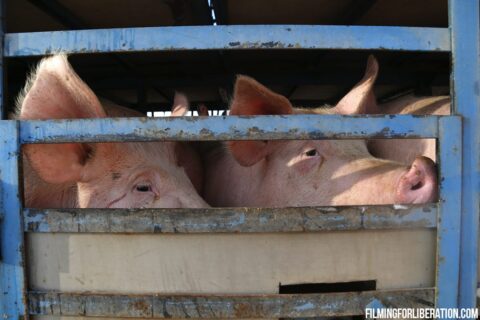Perspective
Critics Declared Veganism Dead in 2025. Here’s What Those Obituaries Are Missing.
Food•5 min read
Perspective
There is no humane way to load a sentient being into a truck to send them off to a death they do not desire. Jessica Scott-Reid examines the fight against the cruel practice of farmed animal transport.

Perspective • Food • Industry

Words by Jessica Scott-Reid
As the large metal transport truck pulls to a brief stop just outside the slaughterhouse, activists rush towards it, quietly clambering to offer water and a few kind words to the dozens of panting, frothing pigs trapped inside. It’s +30 degrees Celsius in Ontario, Canada, and the animals could have been in that truck without food, water or rest for up to 36 hours straight, legally. In Canada, where trucks are open-sided and not required to be equipped with any kind of climate controls, farmed animal transport regulations are considered some of the worst in the western world. But are such standards really better elsewhere?
Transport is often an overlooked step along a farmed animal’s journey towards slaughter, yet it can truly be the most torturous.
“There are approximately 180 pigs on the average truck,” says Toronto Pig Save activist, Lori Croonen, who attends regular vigils outside Fearman’s Pork in Burlington, Ontario. “Many are far too weak to come to us, or simply can’t because they are trapped under other pigs, sometimes dead.” When Croonen reaches animals near the openings of the truck, she says, “I gently tell them I love them and give them a few drops of water.” Their breathing is often very laboured, she adds, “their lips are pulled back from their mouth in extreme dehydration, their snouts are inhaling in and out rapidly to suck in as much oxygen as possible, their eyes show pure exhaustion.” As she offers water with one hand, Croonen uses the other to record or live stream their plight, “to share with the world in hopes people will watch and see them as the individuals they are rather than merely a product for unnecessary food consumption.” Her camera will often fog up, she says, because of the extreme heat coming from inside the truck. “We have taken the temperature with an industrial thermometer and have seen the temperature go as high as +44 degrees Celsius.”
The extreme heat is what prompted another Canadian activist, Anita Krajnc, to also offer water to suffering pigs outside the same slaughterhouse in 2015. Krajnc was famously charged with mischief for her actions, but in 2017 the charges were dropped, in a precedent-setting case (#pigtrial) that has since fuelled the Save Movement across Canada.
“The pigs are mostly just four to six months old,” notes Croonen. “They are terrified, scared, and desperate for kindness and hydration.” By law however, pigs require no such relief. And the situation for other species of farmed animals in Canada, where extreme weather is common, is not any better.
Amendments were recently made to the Canadian Food Inspection Agency’s rules for farmed animal transport, after years of activist, media, and political pressure. But the changes, set to come into play by February 2020, fall far short, including unimpressive travel time reductions, before offering food, water and rest, from 48 hours to 36 for cows, from 36 hours to 28 for pigs and chickens, and from 18 hours to 12 for all animals under eight days old. Not changed is the 72-hour maximum for newly hatched chicks to be confined to transport trucks. And not added are any rules regarding outside temperatures above or below which animals cannot be transported. That’s right, it can never be too hot or too cold to confine animals in open-sided, non-climate controlled trucks in Canada. They are shipped day in and day out, winter, spring, summer and fall.
And despite past reports of pigs and chickens arriving at slaughterhouses already dead, due to extreme weather, the animal ag sector continues to fight against these minimal improvements.
Canadian animal welfare advocates often look to American and EU transport standards with hope. In the US exists the ‘28 hour law,’ which states no farmed animal may be confined in a vehicle or vessel for more than 28 consecutive hours, without unloading the animals for food, water, and rest. There are various amendments to this rule that allow for longer times in different circumstances however, and activists continually complain about a major lack of enforcement. And of course, 28 hours is still an extremely long time to be trapped inside a truck, often with animals not familiar with each other, and rarely with enough room to even lay down.
If you’ve ever been on a cramped eight-hour flight, imagine 28.
In the EU, farmed animal transport is about as good as it gets, with times maxing out at nine hours for calves and piglets, before one hour of rest is required, 14 hours for cows, and 24 hours for pigs (though there is no max travel time for chickens). Trucks are typically more enclosed and must be outfitted with climate controls and monitors to ensure temperatures inside the truck do not fall below 5 degrees Celsius or reach above 30 degrees Celsius.
Still, activists in Europe have long considered these standards to be cruel, and protests against them are ongoing.
Because there is no humane way to load a sentient being into a truck to send them off to a death they do not desire. While activists in Canada, and beyond, fight for improved welfare standards for farmed animals in transport, the true fight is to end the practice altogether, for the pigs suffering heatstroke in the summer, the chickens freezing to death in the winter, and any animal who happens to arrive at slaughter seemingly unscathed. None deserve to be there.
“If they were dogs people would be appalled at their suffering,” says Croonen, “but because they are pigs, people turn away to not feel responsible for it.”